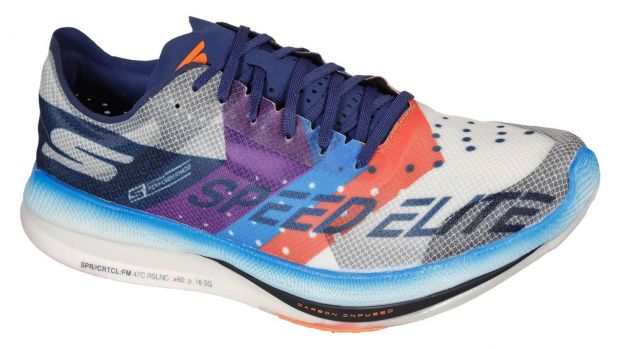Our Verdict
This stripped-back carbon shoe is more akin to a traditional racing flat than something like the Nike Vaporfly, with a fast and firm ride that’s best suited to short events.
For
- Very light and snappy
- More comfortable than a classic racing flat
- Legal stack height for longer track races
Against
- Not as bouncy as many carbon super-shoes
- Firm ride makes it best for short races
You can trust Coach
The template for carbon plate super-shoes was established by the Nike Vaporfly, which combined a high stack of soft and bouncy foam with a full-length plate to stabilise that foam and add propulsion to each step.
It’s a great template, and there are a lot of excellent shoes that employ it to help you perform on race day, but the Skechers GoRun Speed Elite Hyper shows there is more than one way to skin a cat.
The Speed Elite, which has too many words in its name to ever type out in full again, has a far lower stack than most carbon shoes – it’s just 23mm high at the heel. That’s a lot less than the 40mm limit set by World Athletics and even low enough for the Speed Elite to be used in track races over 800m, where the limit is 25mm.
In another departure from the established template, only the front half of the shoe has a carbon plate. This helps ensure the ride is not too firm or harsh, given that there is less foam in the midsole than you normally have on a carbon shoe, while still adding more pop to your toe-off.
There is a super-foam in the midsole though, in the shape of Skechers Hyperburst, which is a carbon dioxide and nitrogen-infused EVA. It’s a very lightweight material, and the Speed Elite weighs just 180g in my UK size 9.

The weight and relatively low stack make the Speed Elite feel like an old-school racing flat to run in, just with a little extra pop from the Hyperburst midsole and forefoot plate. It has a firmer ride than most carbon shoes and, with the lower stack unable to accommodate the scooped full-length plate found on other shoes, it lacks the same propulsive feel. But in the right situation the Speed Elite feels absolutely terrific to run in.
That situation is any time you’re running flat-out. I’ve done several workouts on the track and road plus a 3,000m track race in the Speed Elite, and it felt at its best when going all-out especially on shorter reps. Settle into 5K or 10K pace and it doesn’t offer the same springy feel of other carbon shoes, and it will leave your legs feeling pretty battered the day after a longish run, but there are times when it’s worth that extra recovery time.
The workout I enjoyed the most in the Speed Elite was 20 x one-minute reps, with one minute’s recovery. It’s so light and when you are pushing the pace that hard it feels like you’re barely wearing anything on your foot.
However, the day after that session, which totalled around 16km, I felt the wear on my legs in a way I don’t when using high-stack carbon shoes. Furthermore, when I ran sessions with longer reps, like 12 x 1km or even 16 x 400m, where I was generally hitting around 5K, 10K or half marathon pace, the shoe didn’t feel nearly so good.
In one session I even switched to the New Balance RC Elite v2 to get a bit more cushioning as I rolled through the reps. The Speed Elite isn’t going to wreck your workout, but when you’re training for a long race like a half marathon or marathon you want to bounce back quickly, and the Speed Elite doesn’t allow you to do that as well as a shoe like the New Balance.
See related
The Speed Elite does have one major advantage over most other carbon shoes, which is that it is legal for track races over 800m. I used it for my first stab at a 3,000m event and it was great, providing a little more protection than spikes while being just as quick. If you prefer using road shoes for those events, the Speed Elite is worth checking out.
Aside from that niche, the Speed Elite Hyper faces too much high-quality competition to be a standout pick. That’s not just from £200-plus super-shoes like the Vaporfly or RC Elite v2 either, because I’d also rate options like the Saucony Endorphin Speed 2 or Hoka Rocket X as better options for most runners. They’re more versatile and more comfortable then the Speed Elite for anything over 5K – and pretty much as quick. They also come in cheaper on RRP, though it is worth noting the Speed Elite is often in sales as a slightly older carbon shoe.
Buy from Sports Shoes | £161.99 (Currently reduced to £129.99)

Nick Harris-Fry is a journalist who has been covering health and fitness since 2015. Nick is an avid runner, covering 70-110km a week, which gives him ample opportunity to test a wide range of running shoes and running gear. He is also the chief tester for fitness trackers and running watches, treadmills and exercise bikes, and workout headphones.

